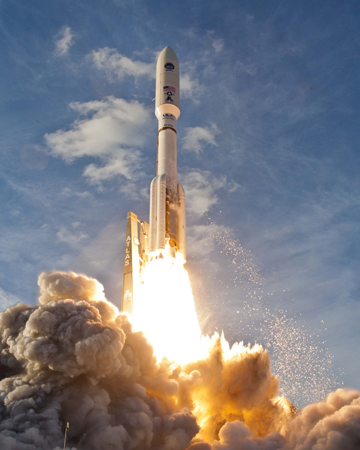Atlas 5 boosts military comsat into space
By WILLIAM HARWOOD
CBS News
A United Launch Alliance Atlas 5 rocket boosted a powerful new Navy communications satellite into orbit Friday evening, the first of five planned relay stations that will act like orbital cell phone towers to provide 3G voice, data and video connectivity to military personnel around the world.
Equipped with five solid-fuel strap-on boosters for extra power, the towering Atlas 5 thundered to life at 5:15 p.m. and majestically climbed away from launch complex 41 at the Cape Canaveral Air Force Station.
The initial stages of the flight went smoothly and the strap-on boosters fell away as planned about a minute and 45 seconds after liftoff. The Atlas first stage and its Russian-built RD-180 engine burned out four minutes and 21 seconds after launch and the flight continued under the power of a Pratt & Whitney RL10 Centaur second stage engine.
Three Centaur firings were planned over three hours to boost the 7.5-ton Mobile User Objective System 1 satellite -- the heaviest payload ever launched by an Atlas -- to its planned orbit 22,300 miles above the equator.
Liftoff came a week behind schedule because of back-to-back delays last week due to high winds aloft and heavy cloud cover from a passing cold front. Atlas rockets have now flown 611 times since 1957, including 29 straight successes for the Atlas 5. It was only the third launch of an Atlas 5 with five solid-fuel boosters, the version used to boost NASA spacecraft to Pluto and Jupiter.
The planned $5 billion MUOS communications network eventually will be made up of four satellites and one spare, each one incorporating 3G cellular technology to provide "significantly improved and assured communications for the mobile warfighter," according to United Launch Alliance.
"MUOS-1 will ultimately replace the current UHF SATCOM system, providing military users with 10 times more communications capability over existing systems, including simultaneous voice, video and data, leveraging 3G mobile communications technology."
Lockheed Martin is building the MUOS satellites to replace the Navy's Ultra High Frequency Follow-On spacecraft.
"A single MUOS satellite provides more communication access than the current UHF constellation," Mark Pasquale, Lockheed Martin vice president and MUOS program manager, told Spaceflight Now. "This capability is critical to the U.S. military because they depend on reliable, targeted communication to complete missions and to protect service members worldwide.
"MUOS is designed to support those requirements by providing users narrowband communications with greater mobility, higher data rates and improved operational availability."
Unlike earlier systems, the MUOS network can be used by smart phones, allowing much wider access to the secure communications network.
CBS News
A United Launch Alliance Atlas 5 rocket boosted a powerful new Navy communications satellite into orbit Friday evening, the first of five planned relay stations that will act like orbital cell phone towers to provide 3G voice, data and video connectivity to military personnel around the world.
Equipped with five solid-fuel strap-on boosters for extra power, the towering Atlas 5 thundered to life at 5:15 p.m. and majestically climbed away from launch complex 41 at the Cape Canaveral Air Force Station.
 |
| A United Launch Alliance Atlas 5 rocket blasts off from the Cape Canaveral Air Force Station, boosting a new military communications satellite toward orbit. (Credit: United Launch Alliance) |
Three Centaur firings were planned over three hours to boost the 7.5-ton Mobile User Objective System 1 satellite -- the heaviest payload ever launched by an Atlas -- to its planned orbit 22,300 miles above the equator.
Liftoff came a week behind schedule because of back-to-back delays last week due to high winds aloft and heavy cloud cover from a passing cold front. Atlas rockets have now flown 611 times since 1957, including 29 straight successes for the Atlas 5. It was only the third launch of an Atlas 5 with five solid-fuel boosters, the version used to boost NASA spacecraft to Pluto and Jupiter.
The planned $5 billion MUOS communications network eventually will be made up of four satellites and one spare, each one incorporating 3G cellular technology to provide "significantly improved and assured communications for the mobile warfighter," according to United Launch Alliance.
"MUOS-1 will ultimately replace the current UHF SATCOM system, providing military users with 10 times more communications capability over existing systems, including simultaneous voice, video and data, leveraging 3G mobile communications technology."
Lockheed Martin is building the MUOS satellites to replace the Navy's Ultra High Frequency Follow-On spacecraft.
"A single MUOS satellite provides more communication access than the current UHF constellation," Mark Pasquale, Lockheed Martin vice president and MUOS program manager, told Spaceflight Now. "This capability is critical to the U.S. military because they depend on reliable, targeted communication to complete missions and to protect service members worldwide.
"MUOS is designed to support those requirements by providing users narrowband communications with greater mobility, higher data rates and improved operational availability."
Unlike earlier systems, the MUOS network can be used by smart phones, allowing much wider access to the secure communications network.